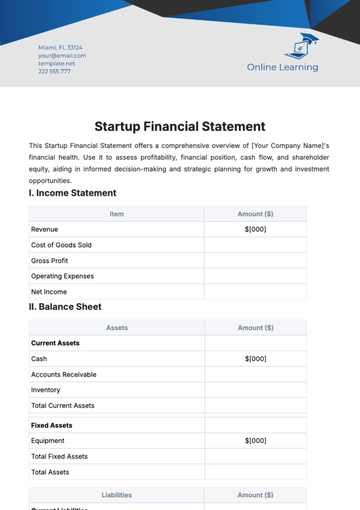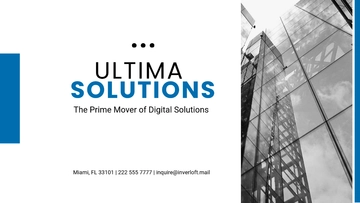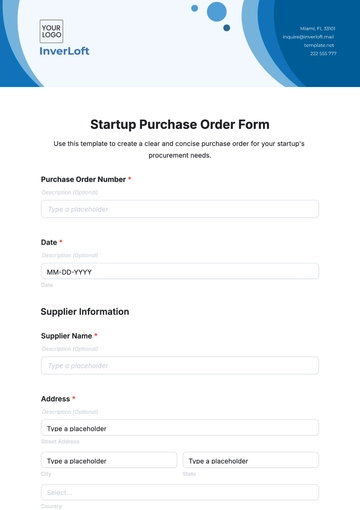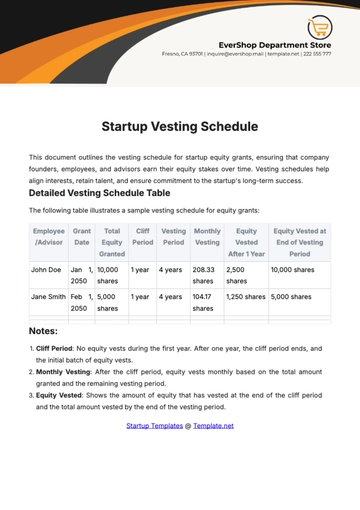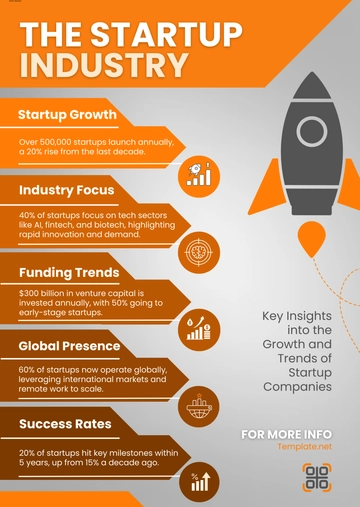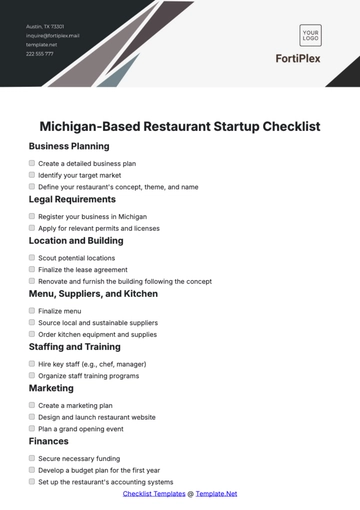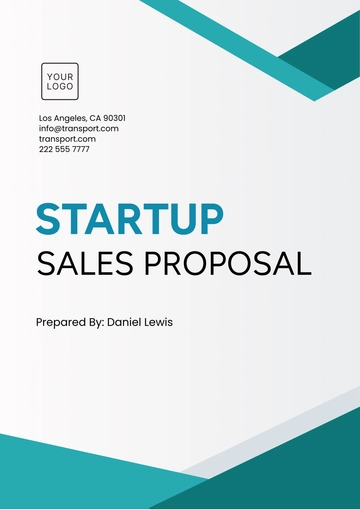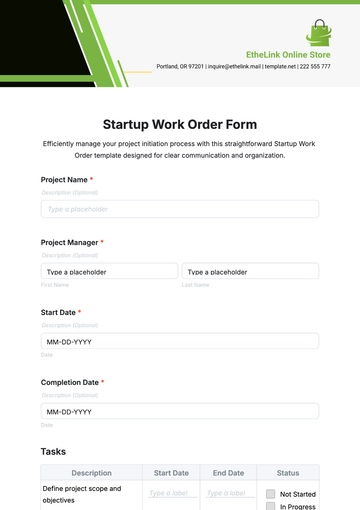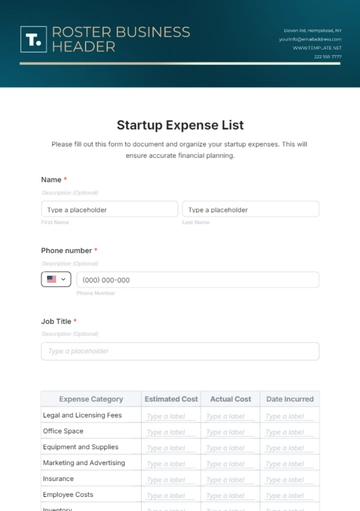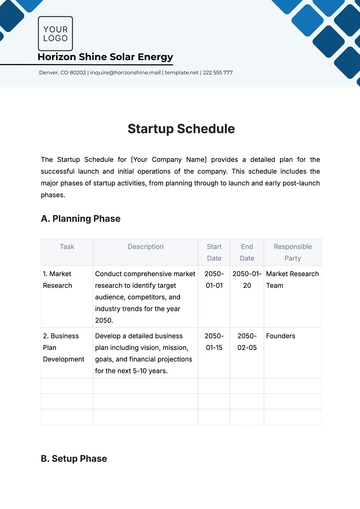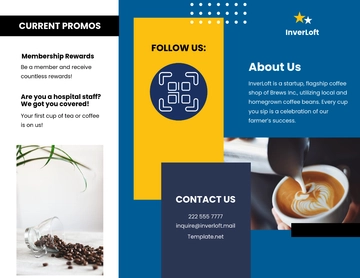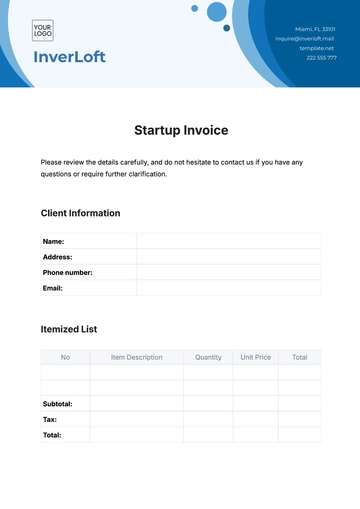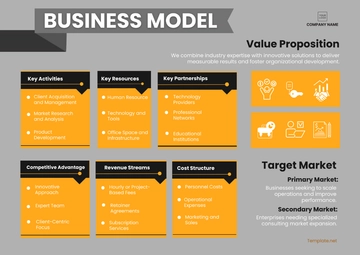Free Startup E-commerce Marketing Strategy
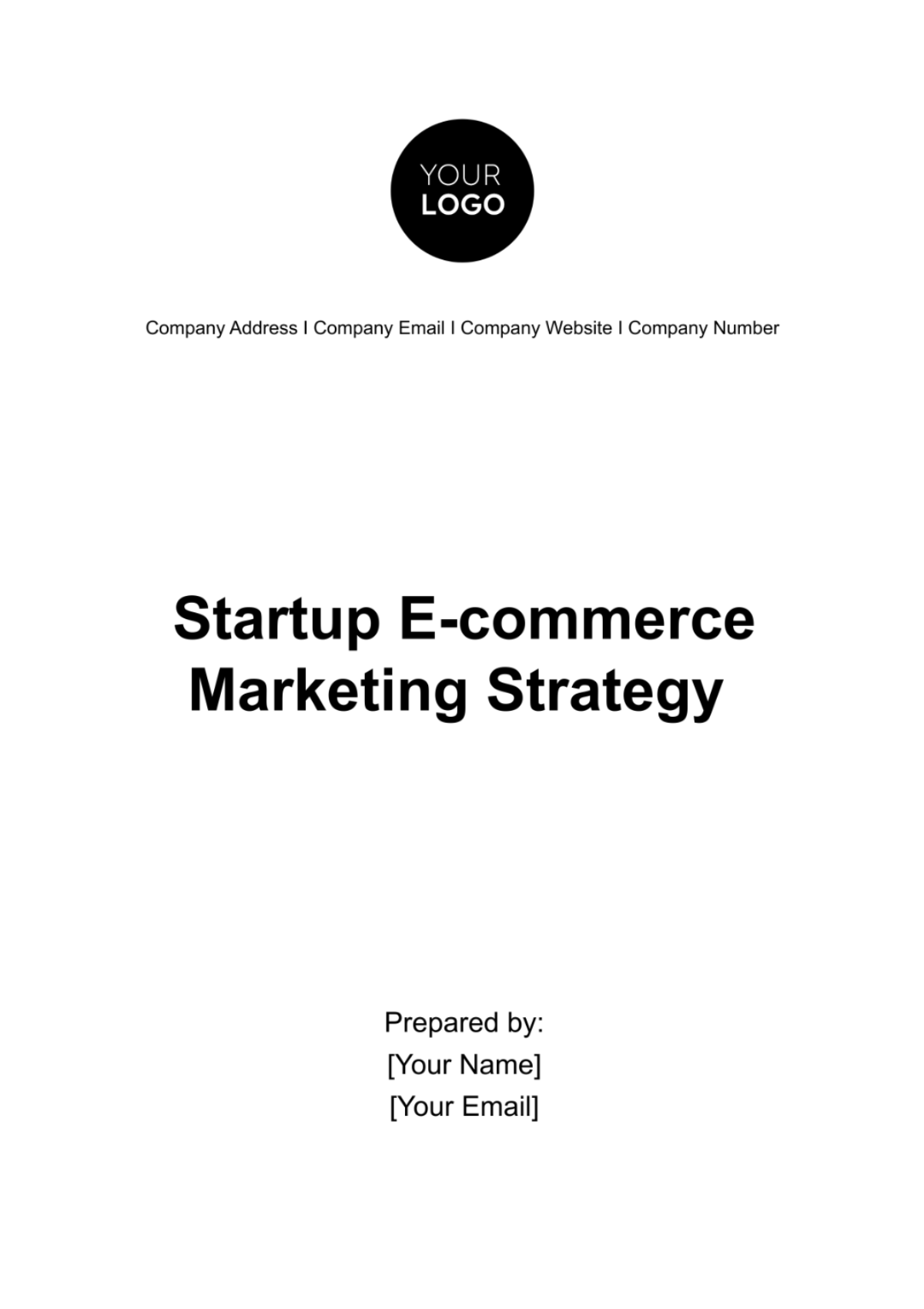
Introduction to the E-commerce Marketing Strategy for [Your Company Name]
In an era where digital storefronts are becoming the main touchpoint between businesses and consumers, establishing a robust online presence is no longer optional for startups—it's imperative. The E-commerce Marketing Strategy for [Your Company Name] is designed to navigate the complexities of online selling and marketing, providing a roadmap to captivate and convert your digital audience. This strategy encompasses understanding your market, optimizing your e-commerce platform, curating your product offerings, leveraging diverse marketing channels, and enhancing customer experience. By the end of this document, [Your Company Name] will be equipped to launch and grow a thriving e-commerce business in a competitive digital landscape.
Part 1: Market and Audience Analysis
Chapter 1: Understanding Your Market
Before diving into the intricacies of e-commerce marketing, it's crucial to lay the groundwork by understanding the market landscape. This involves analyzing current industry trends, identifying key competitors, and positioning [Your Company Name] to stand out.
Industry Trends and Analysis: Stay abreast of emerging trends, such as the rise of mobile commerce, the importance of sustainability, and shifts in consumer behavior post-pandemic. For [Your Company Name], this means ensuring your platform is mobile-optimized and highlighting any eco-friendly aspects of your products.
Competitor Analysis: Identify your main competitors and analyze their strengths, weaknesses, marketing tactics, and customer reviews. This insight will help [Your Company Name] find gaps in the market and opportunities for differentiation.
Market Positioning: Determine how [Your Company Name] fits into the broader market. This could involve focusing on a niche product, offering unparalleled customer service, or leveraging innovative technology to enhance the shopping experience.
Chapter 2: Identifying Your Target Audience for [Your Company Name]
Understanding who your target audience is forms the bedrock of your e-commerce marketing strategy. It's about knowing who you're speaking to, what they need, and how you can serve them. For [Your Company Name], this means diving deep into who your customers are, segmenting them into distinct groups for personalized marketing efforts, and addressing their specific needs and pain points.
Creating Buyer Personas
Buyer personas are semi-fictional representations of your ideal customers based on data and research. They help you understand your customers (and prospective customers) better, making it easier for you to tailor content, messaging, product development, and services to meet their specific needs, behaviors, and concerns.
Sample Buyer Persona for [Your Company Name]
Persona Name: | Tech-Savvy Tim |
Age: | 30-40 years old |
Location: | Urban areas, primarily in tech hubs like San Francisco, New York, or Austin. |
Job Role: | Middle to senior-level positions in tech industries, entrepreneurs, or startup employees. |
Income Level: | $70,000 - $120,000 annually |
Interests: | Latest tech gadgets, productivity tools, smart home devices. |
Challenges: | Finding reliable, cutting-edge tech solutions that integrate seamlessly into a busy, digital-first lifestyle. |
Shopping Behavior: | Values convenience, quality, and customer service. Prefers shopping online and is influenced by product reviews and social proof. |
Understanding Customer Needs and Pain Points
With your buyer personas in place, the next step is to understand their specific needs and pain points. This requires engaging with your audience through surveys, social media interactions, customer feedback, and market research. For Tech-Savvy Tim, the primary need might be for innovative tech solutions that enhance productivity and convenience. His pain points could include navigating the overwhelming number of options in the market and finding trustworthy products that offer genuine innovation and seamless integration into his digital life.
Segmenting Your Audience for Personalized Marketing
Audience segmentation involves dividing your target audience into approachable groups based on certain characteristics, like demographics, behavior, and purchase history. This allows for more targeted and effective marketing strategies.
Table 1: Audience Segmentation for [Your Company Name]
Segment Name | Characteristics | Marketing Approach |
|---|---|---|
Tech Enthusiasts | Early adopters, interested in the latest tech | Highlight innovation, latest features |
Busy Professionals | Value convenience, efficiency | Showcase time-saving and productivity tools |
Eco-Conscious Shoppers | Prefer sustainable and eco-friendly products | Emphasize eco-friendliness, sustainability |
Strategies for Engaging Each Segment
Tech Enthusiasts: Utilize cutting-edge product launches, tech blogs, and influencer partnerships to highlight the innovative aspects of your products.
Busy Professionals: Develop content focused on productivity and efficiency benefits, such as how-to guides, case studies, and time-saving tips.
Eco-Conscious Shoppers: Share behind-the-scenes content on product sourcing, environmental impact, and your brand's sustainability efforts.
By thoroughly understanding your target audience and segmenting them accordingly, [Your Company Name] can craft personalized, effective marketing strategies that resonate with different groups, addressing their unique needs and driving engagement and sales.
Part 2: Developing Your E-commerce Platform
Chapter 3: Choosing the Right E-commerce Platform
The backbone of your online business is your e-commerce platform. It's crucial to select a platform that not only meets your current needs but can also scale with your business.
Comparing Platform Features and Costs: Evaluate platforms like Shopify, WooCommerce, and Magento based on their features, ease of use, scalability, and cost.
Scalability and Integration Capabilities: Ensure the platform can handle increased traffic and sales volume as [Your Company Name] grows. Additionally, check for integration capabilities with other tools and services, such as email marketing software and payment gateways.
User Experience and Mobile Optimization: With a significant portion of online shopping occurring on mobile devices, choose a platform that offers a seamless mobile shopping experience.
Chapter 4: Website Design and User Experience
An intuitive and appealing website design is key to converting visitors into customers.
Building a User-Friendly Website Structure: Organize your site with clear navigation and categorization to help customers find products easily. For [Your Company Name], this might mean categorizing products by type, use case, or target audience.
Optimizing Product Pages for Conversion: Each product page should include high-quality images, detailed descriptions, pricing information, and reviews. Videos demonstrating the product in use can further enhance the page.
Implementing Effective Call-to-Action (CTA) Buttons: CTAs like "Add to Cart," "Buy Now," and "Learn More" should be prominently placed and visually distinct, guiding customers through the purchasing process.
Part 3: Crafting Your Product Offerings
Chapter 5: Product Selection and Presentation
Curating Your Product Line: The products you choose to sell should align with [Your Company Name]'s brand identity and meet your target audience's needs. Conduct market research to identify trending products or gaps in the market that your startup can fill.
Sample Product Line Strategy: If [Your Company Name] targets tech-savvy consumers looking for eco-friendly gadgets, your product line might include solar-powered chargers, eco-friendly phone cases, and biodegradable accessories.
High-Quality Product Photography and Descriptions: Online shoppers rely heavily on visuals and product descriptions to make purchasing decisions. Invest in professional photography and write detailed, persuasive product descriptions highlighting key features and benefits.
Photography Tip: Use a consistent style and background for all product photos to enhance your brand's visual identity. Include multiple angles and zoom-in features to give customers a thorough view.
Pricing Strategies and Competitive Analysis: Your pricing strategy should reflect [Your Company Name]'s market position, costs, and perceived value of your products. Conduct a competitive analysis to ensure your prices are competitive yet profitable.
Competitive Pricing Example: If your main competitor sells a similar eco-friendly charger for $50, consider pricing yours slightly lower if you're entering the market, or higher if your product offers additional features or benefits.
Chapter 6: Inventory Management
Efficient inventory management is crucial to avoid stock outs or excess inventory, which can both negatively impact your bottom line.
Process | Details |
|---|---|
Managing Stock Levels Efficiently | Utilize inventory management software to track stock levels in real-time, automate reordering processes, and analyze sales patterns to predict future inventory needs. |
Strategies for Handling Overstock and Out-of-Stock Items | Develop a plan for dealing with overstock, such as running promotions or bundling products. For out-of-stock items, offer backorder options or recommend alternative products to keep customers engaged. |
Part 4: Marketing and Sales Channels
Chapter 7: Search Engine Optimization (SEO)
Implementing effective SEO strategies is crucial for ensuring that [Your Company Name]'s website and product pages rank high in search engine results, making your offerings more visible to potential customers. Here’s how to refine your approach:
Keyword Research for E-commerce
Use SEO Tools: Leverage tools like SEMrush, Ahrefs, or Google's Keyword Planner to find high-volume, relevant keywords related to your products and industry. Look for a mix of short-tail keywords with high search volume and long-tail keywords that are more specific and less competitive.
Analyze Search Intent: Understand the intent behind the keywords you target—whether users are looking to buy (transactional), seeking information (informational), or comparing products (navigational). Tailor your content and product pages to match this intent.
Competitor Keyword Analysis: Identify which keywords your competitors are ranking for. Analyze their content and SEO strategy to find opportunities for differentiation or to improve upon their approach.
On-Page SEO Best Practices
Practices | Details |
|---|---|
Optimize Product Pages | Ensure each product page uses targeted keywords in the title tag, meta description, product descriptions, and header tags (H1, H2, etc.). This not only helps search engines understand the page content but also entices users to click through from search results. |
Use Schema Markup | Implement schema markup (structured data) to provide search engines with more information about your products, such as price, availability, and reviews. This can enhance your appearance in search results with rich snippets. |
Improve User Experience (UX | Search engines favor websites that provide a great user experience. Ensure your site is mobile-friendly, loads quickly, and has an intuitive navigation structure. Use tools like Google's PageSpeed Insights to identify and fix speed issues. |
Technical SEO for E-commerce Sites
Secure Your Website: Use HTTPS encryption to secure your site. This is a ranking factor for Google and crucial for protecting your customers' information.
Optimize Site Structure: A well-organized site structure improves crawlability and user experience. Use a logical hierarchy for your product categories and include a sitemap to help search engines index your pages.
Address Duplicate Content: E-commerce sites often have duplicate content issues due to product variations (size, color) or similar product descriptions. Use canonical tags to point search engines to the primary version of each page.
Content Marketing Integration
Create Valuable Content: Beyond product pages, develop a content marketing strategy that targets your audience's interests and questions related to your niche. Blog posts, buying guides, and how-to articles can attract organic traffic and build your site's authority.
Internal Linking: Use internal links to connect your content with relevant product pages, making it easier for visitors to find and purchase your products. This also helps distribute page authority throughout your site.
Monitor and Adapt: SEO is an ongoing process. Regularly monitor your rankings, traffic, and website performance. Use analytics to adapt your strategy, focusing on what works and improving areas that lag.
By enhancing your SEO efforts with these advanced strategies, [Your Company Name] can significantly improve its online visibility, attract more targeted traffic, and ultimately increase conversions and sales. Remember, SEO success requires patience, persistence, and continuous optimization to adapt to changing search engine algorithms and market dynamics.
Chapter 8: Content Marketing
For [Your Company Name], a robust content marketing strategy is not just about filling your blog with articles; it's about creating value for your customers and establishing your brand as a thought leader in your industry. Content marketing is a powerful tool that can drive organic traffic, improve SEO, and enhance customer engagement. The key is to produce high-quality, relevant content that addresses the interests, challenges, and questions of your target audience. This could range from detailed product guides and how-to videos to customer stories and industry insights.
By understanding the needs of your audience, [Your Company Name] can tailor content that resonates with them, encouraging shares, and building community. Moreover, content marketing supports your SEO efforts by incorporating targeted keywords naturally, increasing the visibility of your site on search engines. It's also crucial for building backlinks as other sites are more likely to link to informative and valuable content. To maximize the impact, distribute your content across various channels — your website, social media, email newsletters, and even guest posts on relevant blogs. Regularly analyzing the performance of your content through metrics such as page views, shares, and time spent on page will help you refine your strategy and focus on what works best for your audience.
Chapter 9: Social Media Marketing
Social Media Marketing is an indispensable channel for [Your Company Name] to connect with its audience, enhance brand visibility, and drive sales. The dynamic and interactive nature of social media platforms allows your brand to showcase its personality and values, engage in real-time with customers, and monitor consumer trends and feedback closely. Choosing the right platforms is key — where does your target audience spend their time? Is it Instagram's visually rich platform, Twitter's quick conversation style, LinkedIn's professional network, or Facebook's broad user base?
Once platforms are selected, creating engaging, platform-optimized content is crucial. For instance, Instagram demands high-quality visuals and stories, while Twitter is all about concise, impactful messages and interactions. Social media isn't just for posting product photos or sales promotions; it's for telling your brand's story, sharing customer experiences, and providing value through tips, insights, and entertainment. Paid advertising on social media, through targeted ads and influencer collaborations, can also significantly boost your reach and conversions, allowing precise targeting based on demographics, interests, and behaviors.
For [Your Company Name], the goal should be to build a loyal community around your brand, turning customers into brand advocates. Monitoring and engaging with your audience, using social listening tools to track brand mentions, and analyzing the performance of your social media activities are all critical for refining your strategy and achieving better results over time.
Chapter 10: Email Marketing
Email Marketing is an indispensable tool for [Your Company Name], offering a direct line of communication to your customers' inboxes. It's not just about sending emails; it's about creating targeted, personalized messages that engage and convert.
Process | Details |
|---|---|
Building and Segmenting Your Email List | Start by gathering emails through sign-ups on your website, during checkout, or through lead magnets like free guides or discount offers. Segmenting this list allows you to tailor your messaging based on customer behavior, purchase history, and preferences, significantly increasing the effectiveness of your campaigns. |
Crafting Effective Email Campaigns | The success of email marketing lies in sending the right message to the right person at the right time. For [Your Company Name], this might mean welcome emails for new subscribers, promotional emails for sales, and personalized product recommendations based on past purchases. Each email should be crafted with a clear objective, a compelling subject line, and a call to action that drives recipients toward that objective. |
Automation and Personalization Strategies | Utilize email marketing platforms to automate the sending of certain types of emails, like welcome messages, cart abandonment reminders, and re-engagement emails to customers who haven't purchased in a while. Personalization goes beyond using the recipient's name; it's about tailoring the content of the email to match the recipient's interests and interactions with your brand. |
Key Performance Indicators (KPIs) for Email Marketing | Monitor metrics such as open rates, click-through rates, and conversion rates to gauge the effectiveness of your email campaigns. These insights will help you tweak your strategy, testing different content, subject lines, and sending times to continuously improve your results. |
Chapter 11: Pay-Per-Click (PPC) Advertising
Pay-Per-Click (PPC) Advertising is a powerful way for [Your Company Name] to gain immediate visibility in search engine results and on partner websites. It's a model where you pay a fee each time your ad is clicked, making it a direct route to driving targeted traffic.
Setting Up and Managing PPC Campaigns: Begin by selecting relevant keywords that potential customers might use to find your products or services. Tools like Google Keyword Planner can help you identify these keywords. When setting up your campaigns, structure them into logical ad groups based on product categories or customer intents to improve relevance and performance.
Remarketing Strategies to Increase Conversion: Remarketing allows you to show ads to users who have previously visited your website but didn't make a purchase. This is a highly effective strategy because it targets individuals who are already familiar with your brand, increasing the likelihood of conversion.
Measuring PPC Campaign Success: Essential to the success of your PPC efforts is the continuous monitoring and optimization of your campaigns. Use tools provided by platforms like Google Ads and Facebook Ads Manager to track performance metrics such as impressions, clicks, conversion rate, and cost per conversion. Analyzing these metrics provides insights into what's working and what's not, allowing you to make informed adjustments to your campaigns, such as refining your keyword list, adjusting your bids, and optimizing your ad copy and landing pages.
By adhering to these strategies in email marketing and PPC advertising, [Your Company Name] can effectively communicate with its target audience, driving both engagement and conversions. Regular analysis and optimization of your strategies based on performance data will ensure the continued success and growth of your e-commerce business.
Part 5: Customer Experience and Loyalty
Chapter 12: Enhancing Customer Experience
Enhancing the customer experience is pivotal for [Your Company Name] to not only attract but also retain customers in the competitive e-commerce landscape. A positive shopping experience can lead to higher conversion rates, repeat purchases, and brand loyalty.
Streamlining the Checkout Process: Simplify the checkout process to reduce cart abandonment. This includes minimizing the number of steps to purchase, offering multiple payment options, and clearly displaying security badges to reassure customers their data is safe. For example, [Your Company Name] could implement a one-page checkout and remember customer preferences for future visits.
Providing Excellent Customer Service: Exceptional customer service should be a hallmark of [Your Company Name]. This includes offering timely and helpful support across multiple channels such as live chat, email, and social media. Utilizing chatbots for 24/7 assistance and having a well-trained team to handle more complex queries can significantly enhance customer satisfaction.
Implementing Loyalty Programs: Loyalty programs reward repeat customers, encouraging them to continue shopping with [Your Company Name]. Consider offering points for purchases, referrals, or social media shares that customers can redeem for discounts, free shipping, or exclusive products. This not only boosts customer retention but also turns satisfied customers into brand advocates.
Chapter 13: Analytics and Performance Measurement
For [Your Company Name], measuring the effectiveness of your e-commerce marketing strategy is crucial for understanding what drives sales and where to allocate resources.
Process | Details |
|---|---|
Setting Up E-commerce Analytics | Utilize tools like Google Analytics to track key metrics such as website traffic, conversion rate, average order value, and customer acquisition cost. Setting up e-commerce tracking allows you to see detailed information about customer behavior and how different channels contribute to sales. |
Key Performance Indicators (KPIs) for E-commerce | Identify and monitor KPIs that align with [Your Company Name]'s business goals. These might include site traffic, conversion rate, cart abandonment rate, return on ad spend (ROAS), and customer lifetime value (CLTV). Regularly reviewing these KPIs will help you understand your e-commerce business's health and areas for improvement. |
Using Data to Drive Decision Making | The insights gained from analytics should inform your marketing decisions. For example, if data shows that a significant portion of traffic comes from mobile devices but the conversion rate is low, [Your Company Name] might need to optimize the mobile shopping experience. Continuously testing and learning from the data will enable you to refine your marketing strategies and improve ROI over time. |
Conclusion: Growing Your E-commerce Business with [Your Company Name]
As we wrap up the E-commerce Marketing Strategy for [Your Company Name], it's clear that success in the digital marketplace requires a comprehensive approach. From understanding your audience and market to developing a user-friendly e-commerce platform, curating appealing product offerings, and leveraging various marketing channels to enhance customer experience, each component plays a crucial role in building a successful online business.
The journey doesn't end here; e-commerce is an ever-evolving field, and staying agile, continuously analyzing performance, and being willing to adapt your strategy are key to staying ahead of the curve. Embrace innovation, listen to your customers, and always strive to exceed their expectations.
Remember, the ultimate goal of [Your Company Name]'s E-commerce Marketing Strategy is not just to sell products but to build lasting relationships with your customers, turning them into loyal advocates for your brand. With dedication, creativity, and data-driven decision-making, [Your Company Name] is well on its way to achieving sustained growth and success in the e-commerce space. Here's to your success and the exciting journey ahead!
- 100% Customizable, free editor
- Access 1 Million+ Templates, photo’s & graphics
- Download or share as a template
- Click and replace photos, graphics, text, backgrounds
- Resize, crop, AI write & more
- Access advanced editor
Increase your online store to success with the Startup E-commerce Marketing Strategy Template from Template.net. Tailored for the digital marketplace, this template is fully customizable and editable via our AI Editor Tool, ensuring your marketing efforts hit the mark. Drive sales, engage customers, and outpace competitors with the cutting-edge strategies provided by Template.net.
You may also like
- Startup Agreement
- Non Profit
- Transport and Logistics
- Education
- IT Services and Consulting
- Startup Presentation
- Startup Business Plan
- Startup Proposal
- Startup Plan
- Startup Brochure
- Startup Form
- Startup Flyer
- Startup Checklist
- Startup Budget
- Startup Poster
- Startup Contract
- Startup Invoice
- Startup Letterhead
- Startup Quotes

